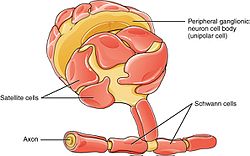
Back Schwannsel Afrikaans خلية شوان Arabic Шванова клетка Bulgarian Schwannove ćelije BS Cèl·lula de Schwann Catalan خانەی شوان CKB Schwannova buňka Czech Schwann-celle Danish Schwann-Zelle German Célula de Schwann Spanish
| Schwann cell | |
|---|---|
 Schwann cells (red, cylindral cells at bottom) on a neuron (yellow) in the PNS | |
| Identifiers | |
| MeSH | D012583 |
| FMA | 62121 |
| Anatomical terms of neuroanatomy | |
Schwann cells or neurolemmocytes (named after German physiologist Theodor Schwann) are the principal glia of the peripheral nervous system (PNS). Glial cells function to support neurons and in the PNS, also include satellite cells, olfactory ensheathing cells, enteric glia and glia that reside at sensory nerve endings, such as the Pacinian corpuscle. The two types of Schwann cells are myelinating and nonmyelinating.[1] Myelinating Schwann cells wrap around axons of motor and sensory neurons to form the myelin sheath. The Schwann cell promoter is present in the downstream region of the human dystrophin gene that gives shortened transcript that are again synthesized in a tissue-specific manner.
During the development of the PNS, the regulatory mechanisms of myelination are controlled by feedforward interaction of specific genes, influencing transcriptional cascades and shaping the morphology of the myelinated nerve fibers.[2]
Schwann cells are involved in many important aspects of peripheral nerve biology – the conduction of nervous impulses along axons, nerve development and regeneration, trophic support for neurons, production of the nerve extracellular matrix, modulation of neuromuscular synaptic activity, and presentation of antigens to T-lymphocytes.
Charcot–Marie–Tooth disease, Guillain–Barré syndrome (acute inflammatory demyelinating polyradiculopathy type), schwannomatosis, chronic inflammatory demyelinating polyneuropathy, and leprosy are all neuropathies involving Schwann cells.
- ^ Bhatheja, K; Field, J (2006). "Schwann cells: origins and role in axonal maintenance and regeneration". The International Journal of Biochemistry & Cell Biology. 38 (12): 1995–99. doi:10.1016/j.biocel.2006.05.007. PMID 16807057.
- ^ Cite error: The named reference
:3was invoked but never defined (see the help page).